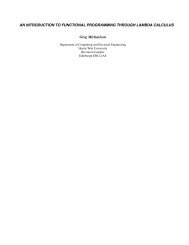Contents
Contents
Contents
You also want an ePaper? Increase the reach of your titles
YUMPU automatically turns print PDFs into web optimized ePapers that Google loves.
AMATH 581 ( c○J. N. Kutz) 11Upon integration and evaluation at the upper and lower limits, we find thefollowing 2nd order Adams-Moulton schemey n+1 = y n + ∆t2 [f(t n+1, y n+1 )+f(t n , y n )] . (1.1.28)Once again this is a two-step algorithm. However, it is categorically differentthan the Adams-Bashforth methods since it results in an implicit scheme,i.e. the unknown value y n+1 is specified through a nonlinear equation (1.1.28).The solution of this nonlinear system can be very difficult, thus making explicitschemes such as Runge-Kutta and Adams-Bashforth, which are simpleiterations, more easily handled. However, implicit schemes canhaveadvantageswhen considering stability issues related to time-stepping. This is explored furtherin the notes.One way to circumvent the difficulties of the implicit stepping methodwhilestill making use of its power is to use a Predictor-Corrector method. Thisschemedraws on the power of both the Adams-Bashforth and Adams-Moulton schemes.In particular, the second order implicit scheme given by (1.1.28) requires thevalue of f(t n+1 , y n+1 )intherighthandside. Ifwecanpredict(approximate)this value, then we can use this predicted value to solve (1.1.28) explicitly. Thuswe begin with a predictor step to estimate y n+1 so that f(t n+1 , y n+1 )canbeevaluated. We then insert this value into the right hand side of (1.1.28) andexplicitly find the corrected value of y n+1 .Thesecond-orderpredictor-correctorsteps are then as follows:predictor (Adams-Bashforth): y P n+1 =y n + ∆t2 [3f n − f n−1 ] (1.1.29a)corrector (Adams-Moulton): y n+1 =y n + ∆t2 [f(t n+1, y P n+1 )+f(t n, y n )]. (1.1.29b)Thus the scheme utilizes both explicit and implicit time-stepping schemes withouthaving to solve a system of nonlinear equations.Higher order differential equationsThus far, we have considered systems of first order equations. Higherorderdifferentialequations can be put into this form and the methods outlined here canbe applied. For example, consider the third-order, nonhomogeneous, differentialequationd 3 u du+ u2 +cost · u = g(t) . (1.1.30)dt3 dtBy definingy 1 = uy 2 = dudt(1.1.31a)(1.1.31b)
















